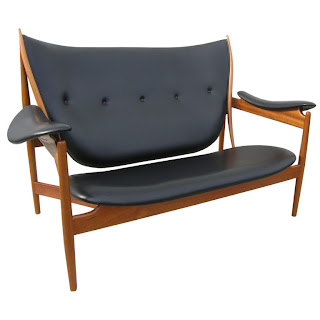Juhl began a longstanding collaboration with the cabinetmaker Neils Vodder in the late 1930s. Their pieces were frequently shown at the annual exhibitions of the Danish Cabinetmakers' Guild. His early chairs were handmade in small quantities, featuring the floating backs and seats which came to characterize his work and to emphasize its sculptural quality. Unlike his contemporaries, Juhl placed more value on form and less on function, a serious break with the Klint School.
Edgar Kaufmann Jr., whose father had commissioned Fallingwater from Frank Lloyd Wright, introduced Juhl´s work to America. By the early 1950´s Juhl, who had opened his own office, was designing a furniture collection for Baker, and an exhibit for the "Good Design" show in Chicago. He was also selected to design the Trusteeship Council Chamber for United Nations headquarters in New York.
Among Juhl´s notable designs are the Pelican chair (1940), Chieftain armchair (1949) and the Bwana chair and ottoman (1962). Juhl´s work won gold medals at several Milan Triennale, and was exhibited across Europe and the United States.
 |
| Rare double Chieftain chair, 1949 1stdibs.com |
 |
| Pelican chair finnjuhl.com |
 |
| Bwana chair treadwaygallery.com |
 |
| 48 chair 1stdibs.com |
 |
| 53 chair 1stdibs.com |






Finn Juhl is leader of the pack to me. His sweeping designs are breathless. Thanks for this great post. The 48 and 53 are favorites! DROOLING!!
ReplyDelete